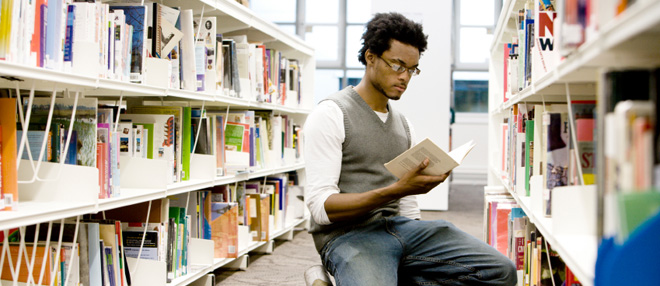September 19th, 2011
Although the past century witnessed swelling educational opportunities for America’s minority students, a history of unjust marginalization means serious work still needs doing. Even today. While many issues associated with minority schooling enjoy steady improvements deserving accolades, that doesn’t lessen the imperative to constantly strive towards equality any. The following statistics, by no means comprehensive, illustrate some areas where the education system needs to pay serious attention. Administrators, teachers, policymakers, parents and students must all do their part to ensure every American child and teen receives the viable education to which he and/or she is fully entitled.

-
Stereotyping impairs performance
A startling Ohio State University study exploring the effects of racial stereotyping uncovered some very unfortunate truths. Nearly 160 African-American students were asked to write an essay about an average college student, either named "Tyrone" or "Erik," with the implication being that the former is black and the latter white. Those assigned Tyrone scored an average of 4.5 on a standardized test, while Team Erik ended up with 6.2. Although possessing equal academic aptitude, researchers believe prevailing stereotypes negatively impact performance — thus creating an unjust cycle reinforced by students and teachers alike.
-
Hispanic high school students had the highest dropout rate in 2009
The National Center for Educational Statistics shows that 17.6% of Hispanic high school students drop out before completing their diplomas or GEDs. Reasons vary from kid to kid, of course, and do not necessarily denote poor grades or discipline. On a positive note, however, Hispanic dropout rates decline steadily every year, with 2008 seeing 18.3% of the high school population leaving before graduating.
-
Minorities comprise 32% of undergraduate enrollees
Undergraduate enrollment has actually increased among all racial and ethnic demographics, although minorities remain heavily underrepresented on American college campuses. Only 32% of postsecondary students are minorities as of 2004 statistics, but their numbers increase yearly — certainly a positive trend. Between 1976 and 2004, Asians and Pacific Islanders experienced the highest rate of increase, boasting a whopping 461%. So while the number still seems low these days, minorities are definitely catching up on campus and enjoy more opportunities to have their voices heard and heeded.
-
Minorities comprise 25% of graduate enrollees
With increased minority undergraduate enrollment came more representation in graduate programs, though at a slower pace. 2004 statistics showed that 25% of master’s and doctoral students were minorities, up from 11% in 1976. The most rampant increase occurred among Hispanics, at 377%. Once again, there’s absolutely nothing "scary" about more opportunities and representation in higher education. But the numbers could definitely be higher, especially since more enrollees means more imperative to address diverse needs.
-
Black, non-Hispanic or Latino students are the most bullied middle and high-school students
Just over 29% of caucasian students between the ages of 12 and 18 say they’ve been bullied, with black, non-Hispanic or Latino almost tying them at 29.1% – a negligible difference, really. During the 2008-2009 school year, 45.1% of instances took place "in a hallway or stairwell," followed by 38.4% "in a classroom." Across all demographics, more bullying takes place in 6th grade (39.4%) and lobbed at students from low-income households (32.3% at the $7,500 to $14,999 level).
-
Nearly 80% of Hispanic 4th graders qualify for free or reduced-price lunch
The statistics — 77%- only cover public schools, however. And that 77%? That represents the total. A staggering 84% of Hispanic 4th graders in town areas come from homes qualifying them for free or reduced-price lunches, compared to 82% of urban, 70% suburban and 72% rural.
-
Minorities comprise 10.2% of private school principals
In total, of course, as statistics vary rapidly depending on what — if any — denomination owns and operates the schools in question. Seventh-Day Adventist institutions lead the way, with 26.4% minority principals. Administrators of black, non-Hispanic or Latino descent are most prevalent, particularly in Seventh-Day Adventist (17.7%) and Pentecostal (14.7%) schools. They also make up 5.2% of total minority principals. When it comes to private education, more needs doing to ensure minority students and staff alike see their requests properly met.
-
The majority of black and Hispanic students attend high-poverty schools
Statistics from 2005 school year revealed that black and Hispanic students populate high-poverty schools more than any other minority. The National Center for Education Statistics considers "high-poverty schools," which are those with 75% or more attendees receiving free or reduced-price lunches. Forty-eight percent of black and 49% of Hispanic 4th graders hail from such desperately wanting institutions, while Asians and Pacific Islanders are more evenly distributed across economic demographics.

-
Hispanic and black students are less likely to have internet access at home
Because of this, they adapt to classroom technology at a slower pace than their white, Asian and Native American peers. Twenty-six percent of Hispanic and 27% of black students use the internet at home, compared to 58% of Asian and 47% of Native American kids, resulting in a very unfortunate achievement gap. Numbers are improving, of course, but there’s still a ways to go before the gulf starts shrinking.
-
Asian and Hispanic students struggle most with speaking English
No matter the grade level, English proves most challenging for Asian and Hispanic students who speak another language at home. The most vulnerable, at 18.8%, are Hispanics in kindergarten through 8th grade, followed by 16.9% of Asians in the same age range. Once the former hits high school, the percentage drops to 14.5%, while the latter only improves its English language skills by .3%. With so many students admitting they grapple with speaking something unfamiliar, schools must find more ways to reach out and help them catch up in a way that doesn’t impede their other lessons.
-
Schools with black or Hispanic majorities are more likely to hire underqualified or novice teachers
In fact, 25% of math educators at schools with 50% or more black students do not hold a degree or any other qualifications in the subjects they teach — probably the most egregious example. And once said teachers rack up the experience, they usually flee to more affluent (and white) areas. Such an unfortunate and enduring phenomenon plays a major role in perpetuating, if not outright widening, the achievement gap. Without knowledgeable, experienced and engaged teachers, students in affected schools typically lag behind and never receive the academic opportunities that should be afforded all youngsters.
-
Native American students significantly lag behind on taking AP exams
Although every demographic — including whites — sees more and more students participating in AP exams yearly, those of Native American descent are far less likely to go for it. In 2008, only 7,750 across the States sat down for the intensive tests. Hispanic students boasted the higher turnout, with a turnout of 209,721, and their black peers enjoyed the highest increase over the past decade. The year 1999 saw 31,023 black students show up for AP exams, compared with 108,545 in 2008, meaning their participation improved by 249.9%.
-
More black students repeat grades than any other racial or ethnic demographic
Both genders, too. In 2007, 25.6% of black males and 15.3% of black females between kindergarten and 12th grade had repeated at least one grade. These numbers, though, only reflect the issue as it relates to public school students.
-
More black students receive suspensions and expulsions than any other racial or ethnic demographic
Between 6th and 12th grades, the 2007 school year saw 49.5% of black males and 34.7% of black females reporting that they had received at least one suspension in their academic careers. When it comes to expulsions, 16.6% of males and 8.2% of females said they had been dismissed from school at least once.
-
Hispanic teenagers have the highest pregnancy rate
In 2007, 81.7 out of every 1,000 Hispanic teenage girls gave birth — more than any other race or ethnicity. Across all demographics, however, the numbers are steadily decreasing. This probably has something to do with improved sex education and easier access to necessary birth control devices, though the problem still requires considerable intervention. Especially since popping out babies as a high schooler is all trendy these days.
-
Mixed-race students who never completed high school experience the highest unemployment rate
And the most vulnerable demographic consistently remains those between the ages of 16 and 24. In 2008, a shocking unemployment rate settled at 33.8% of mixed-race individuals within the temporal and educational criteria. Amongst all races, the unemployment rate shrinks in correlation with the level of schooling completed.
-
Native Hawai’ian and Pacific Islander students are more likely to bring a weapon to school
Typically, students of all races’ motivations lay far more with self-defense than causing any real trouble. By the 2007 school year, 9.5% of Native Hawai’ian and Pacific Islander high school students admitted to carrying a weapon on campus. Considering 38.5% of them — the highest percentage amongst all racial and ethnic demographics — know drugs are available practically in their classrooms, such measures make perfect sense.
No comments:
Post a Comment